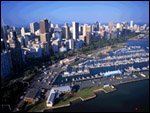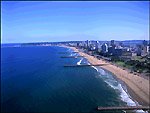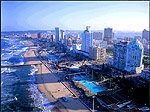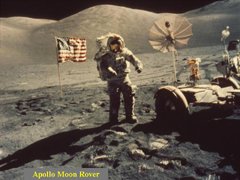DURBAN - A GATE WAY TO SOUTHERN AFRICA
More Information: [South Africa] [Durban with street map]
Since being sighted by Vasco da Gama in 1497, Durban's natural harbour has given birth to a vibrant, go-ahead and ever changing city. Apart from having the busiest harbour in Africa, Durban is served by its own international airport only 15 minutes from its Central Business District. The attractive Yacht basin near the hub continues to provide anchorage and a safe haven for sailors from around the globe.
Durban is an ideal base from which to explore the beauty and splendors of Southern Africa. Within two hours you could be on a safari at one of the country's renowned game reserves - home to some of the world's rarest and most exotic species - or you could be in the fairest Cape. Ninety minutes by road and you could be hiking or trout fishing in the magnificent Drakensberg mountains.
Other options: a day or two away could put you at the origins of man in the Sterkfontein Caves or in the midst of a miraculous flower transformation in the Namaqualand Desert. You could be etching into memory the glorious sunsets and camp fires of the Kruger and other National Parks in South Africa, visit neighbouring Zimbabwe to witness the majesty of the Victoria Falls, game parks of Botswana or Skeleton Coast in Namibia.
There are many faces to Durban - city of great beauty and cultural diversity where you can witness the Dance of the Virgins, a Zulu war dance and attend a performance of the ballet or Opera all in the same day. The only constant is the famous South African weather - and Durban can serve up the best of it, with an average of 320 sunny days a year. A surfer's paradise and international holiday mecca. Mile upon mile of unspoiled, sun-soaked beaches, bronzed life guards and bikini beauties. Seagulls, pelicans and exotic birds. Colourful rickshas, beautiful parks, sidewalk cafes and restaurants. Here architecture encapsulates the diverse histories and cultures of the people. Graceful Victorian buildings, exotic temples and dignified mosques all stand side by side.
|



 go2africa.com Interactive map of SA go2africa.com Interactive map of SA
Back to the Top
|


